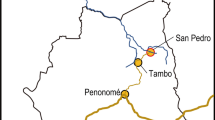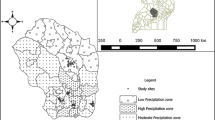Abstract
Specialty coffee (SC) production enables farmers to earn premium prices for high-quality coffee. In Bolivia, some coffee-based agroforestry systems (CAFS) produce SC. However, while many Bolivian families’ livelihoods depend on coffee, studies on SC-producing CAFS remain scarce. Yet, research on tree diversity, CAFS management and the factors affecting tree diversity can offer novel insights on agroforestry. We sampled 24 farms in three villages located in the Caranavi municipality. We analyzed farms main characteristics, biophysical variables, shade tree diversity, tree uses, management practices and farmers’ socioeconomic background. Additionally, we surveyed 50 coffee farmers to collect information about preferences for tree species and tree characteristics. Then, we investigated if farmers’ socioeconomic and farm biophysical variables affect CAFS tree species richness and tree density using generalized linear models (GLM). Our results showed that studied farms are small and certified properties (average: 2.6 hectares) managed by families; we observed that CAFS provide farmers with useful products besides SC. 85 tree species, primarily serving as shade providers for coffee, were identified. These species also yield valuable resources like: fruits, timber, lumber, and medicinal products. Accordingly, surveyed farmers exhibit preference for tree species offering useful and marketable products, with tree characteristics selected based on their advantages for coffee and farmers. GLM revealed that socioeconomic and biophysical variables affect species richness and density. Additional research is needed to evaluate the relationship between biodiversity and the social-economic sustainably of Bolivian CAFS. Likewise, is necessary to enhance farmers’ ability to manage their CAFS for biodiversity conservation and household wellbeing.




Similar content being viewed by others
References
Abebe T, Sterck FJ, Wiersum KF, Bongers F (2013) Diversity, composition and density of trees and shrubs in agroforestry homegardens in Southern Ethiopia. Agrofor Syst 87:1283–1293. https://doi.org/10.1007/s10457-013-9637-6
Albertin A, Nair PKR (2004) Farmers’ perspectives on the role of shade trees in coffee production systems: an assessment from the Nicoya Peninsula, Costa Rica. Hum Ecol 32:443–463. https://doi.org/10.1023/B:HUEC.0000043515.84334.76
Asase A, Tetteh DA (2010) The role of complex agroforestry systems in the conservation of forest tree diversity and structure in southeastern Ghana. Agrofor Syst 79:355–368. https://doi.org/10.1007/s10457-010-9311-1
Bacon C (2005) Confronting the coffee crisis: can fair trade, organic, and specialty coffees reduce small-scale farmer vulnerability in Northern Nicaragua? World Dev 33:497–511. https://doi.org/10.1016/j.worlddev.2004.10.002
Belay B, Zewdie S, Mekuria W et al (2019) Woody species diversity and coffee production in remnant semi-natural dry Afromontane Forest in Zegie Peninsula, Ethiopia. Agrofor Syst 93:1793–1806. https://doi.org/10.1007/s10457-018-0285-8
Bote AD, Struik PC (2011) Effects of shade on growth, production and quality of coffee (COFFEA ARABICA) in Ethiopia. J Hortic for 3:336–341
Buckley YM (2015) Generalized linear models. In: Fox GA, Negrete-Yankelevich S, Sosa VJ (eds) Ecological statistics. Oxford University Press, pp 131–148
Burnham KP, Anderson DR (2002) Model selection and multimodel inference: a practical information-theoretic approach, 2nd edn. Springer, New York
Gentry AH (1982) Patterns of neotropical plant species diversity. In: Hecht MK, Wallace B, Prance GT (eds) Evolutionary biology. Springer, Boston, pp 1–84
Hundera K, Aerts R, Fontaine A et al (2013) Effects of coffee management intensity on composition, structure, and regeneration status of ethiopian moist evergreen afromontane forests. Environ Manag 51:801–809. https://doi.org/10.1007/s00267-012-9976-5
Kabir ME, Webb EL (2009) Household and homegarden characteristics in southwestern Bangladesh. Agroforest Syst 75:129–145. https://doi.org/10.1007/s10457-008-9142-5
Killeen TJ, García EE, Beck S et al (eds) (1993) Guía de árboles de Bolivia. Editorial Instituto de Ecología, La Paz
Kindt R, Simons AJ, Van Damme P (2004) Do farm characteristics explain differences in tree species diversity among Western Kenyan Farms? Agrofor Syst 63:63–74. https://doi.org/10.1023/B:AGFO.0000049434.54654.97
Magurran AE (2003) Measuring biological diversity. Blackwell Publishing, Malden
Manson RH, Contreras A, López-Barrera F (2008) Estudios de la biodiversidad en cafetales. In: Manson RH, Hernández-Ortiz V, Gallina S, Mehltreter K (eds) Agroecosistemas cafetaleros de Veracruz: biodiversidad, manejo y conservación, 1st edn. Instituto de Ecología: Instituto Nacional de Ecología, México, pp 1–14
McCullagh P, Nelder JA (1989) Generalized linear models. Springer, Boston
Méndez VE, Gliessman SR, Gilbert GS (2007) Tree biodiversity in farmer cooperatives of a shade coffee landscape in western El Salvador. Agr Ecosyst Environ 119:145–159. https://doi.org/10.1016/j.agee.2006.07.004
Méndez VE, Bacon CM, Olson M et al (2010) Agrobiodiversity and shade coffee smallholder livelihoods: a review and synthesis of ten years of research in central America. Prof Geogr 62:357–376. https://doi.org/10.1080/00330124.2010.483638
Moguel P, Toledo VM (1999) Biodiversity conservation in traditional coffee systems of Mexico. Conserv Biol 13:11–21. https://doi.org/10.1046/j.1523-1739.1999.97153.x
Orozco L, López A, Rojas M, Somarriba E (2005) Tipologías de fincas cafetaleras con sombra de maderables en Pérez Zeledón, Costa Rica. Agrofor Am 43:86–91
Perfecto I, Rice RA, Greenberg R, van der Voort ME (1996) Shade coffee: a disappearing refuge for biodiversity. Bioscience 46:598–608. https://doi.org/10.2307/1312989
Quandt A, Neufeldt H, Gorman K (2023) Climate change adaptation through agroforestry: opportunities and gaps. Curr Opin Environ Sustain 60:101244. https://doi.org/10.1016/j.cosust.2022.101244
R Core Team (2021) R: A language and environment for statistical computing. R Foundation for Statistical Computing, Vienna
Reynel C, Pennington TD (1997) El género inga en el Perú: morfología, distribución y usos. Royal Botanic Gardens, Kew
Schuit P, Moat J, Gole TW et al (2021) The potential for income improvement and biodiversity conservation via specialty coffee in Ethiopia. Peer J 9:1–29. https://doi.org/10.7717/peerj.10621
Silva Neto FJ, Morinigo KPG, Guimarães NF et al (2018) Shade trees spatial distribution and its effect on grains and beverage quality of shaded coffee trees. J Food Qual 2018:1–8. https://doi.org/10.1155/2018/7909467
Smith Dumont E, Gassner A, Agaba G et al (2019) The utility of farmer ranking of tree attributes for selecting companion trees in coffee production systems. Agrofor Syst 93:1469–1483. https://doi.org/10.1007/s10457-018-0257-z
Somarriba E, Harvey CA, Samper M et al (2004) Biodiversity conservation in neotropical coffee (Coffea arabica) plantations. In: Schroth G, da Fonseca GAB, Harvey CA et al (eds) Agroforestry and biodiversity conservation in tropical landscapes. Island Press, Washington, pp 198–226
Sood KK, Mitchell CP (2009) Identifying important biophysical and social determinants of on-farm tree growing in subsistence-based traditional agroforestry systems. Agrofor Syst 75:175–187. https://doi.org/10.1007/s10457-008-9180-z
Soto-Pinto L, Romero-Alvarado Y, Caballero-Nieto J, Segura G (2001) Woody plant diversity and structure of shade-grown-coffee plantations in Northern Chiapas, Mexico. Rev Biol Trop 49:977–987
Tesfay F, Moges Y, Asfaw Z (2022) Woody species composition, structure, and carbon stock of coffee-based agroforestry system along an elevation gradient in the moist mid-highlands of Southern Ethiopia. Int J for Res 2022:1–12. https://doi.org/10.1155/2022/4729336
Toledo VM, Moguel P (2012) Coffee and sustainability: the multiple values of traditional shaded coffee. J Sustain Agric 36:353–377. https://doi.org/10.1080/10440046.2011.583719
Torrico-Albino JC, Jürgen Pohlan HA, Quispe JL (2019) Estado del arte y demanda formativa para la revitalización de cafetales en los yungas de Bolivia. CienciAgro 9:28–41
Valencia V, García-Barrios L, West P et al (2014) The role of coffee agroforestry in the conservation of tree diversity and community composition of native forests in a Biosphere Reserve. Agr Ecosyst Environ 189:154–163. https://doi.org/10.1016/j.agee.2014.03.024
Valencia V, West P, Sterling EJ et al (2015) The use of farmers’ knowledge in coffee agroforestry management: implications for the conservation of tree biodiversity. Ecosphere 6:1–17. https://doi.org/10.1890/ES14-00428.1
Worku M, Lindner A, Berger U (2015) Management effects on woody species diversity and vegetation structure of coffee-based agroforestry systems in Ethiopia. Small-Scale for 14:531–551. https://doi.org/10.1007/s11842-015-9305-y
Zapata PC (2019) Composición y estructura del dosel de sombra en sistemas agroforestales con café de tres municipios de Cundinamarca, Colombia. Ciênc Florest 29:685–697. https://doi.org/10.5902/1980509827037
Zúñiga C, Somarriba E, Sánchez V (2004) Tipologías cafetaleras de la Reserva Natural Miraflor-Moropotente, Estelí, Nicaragua. Agrofor Am 41–42:105–111
Acknowledgements
We thank the Caranavi farmers who allowed access to their farms. Special thanks to M. Mercado and M. Zárate for supporting tree identification, to C. Ifejika-Speranza, K. Naoki and C. Campos-Villanueva for their commentaries and to our field guides: S.R. López-Gutiérrez, T. Flores, W. Quisbert, S. Condorsett and S.V. Condori-Coarite.
Funding
This research received funding from the project “Exploring the interlinkages between specialty coffee farms’ biodiversity and farmers practices in Bolivia” Seed Money Grant 1912, with the financial support of the Leading House for the Latin American Region, Latin-American-Swiss Center (CLS-HSG), University of St. Gallen and the State Secretariat for Education, Research and Innovation (SERI), Switzerland.
Author information
Authors and Affiliations
Contributions
All authors designed the study. GGT and NAA performed data collection and analysis. GGT wrote the initial draft of the manuscript; all authors contributed to revisions and approved the submitted version.
Corresponding author
Ethics declarations
Conflict of interest
The authors declare no competing interests.
Additional information
Publisher's Note
Springer Nature remains neutral with regard to jurisdictional claims in published maps and institutional affiliations.
Supplementary Information
Below is the link to the electronic supplementary material.
Rights and permissions
Springer Nature or its licensor (e.g. a society or other partner) holds exclusive rights to this article under a publishing agreement with the author(s) or other rightsholder(s); author self-archiving of the accepted manuscript version of this article is solely governed by the terms of such publishing agreement and applicable law.
About this article
Cite this article
Torrico, G.G., Antezana Alvarado, N., Pacheco, L.F. et al. Socioeconomic and biophysical factors affect tree diversity in farms producing specialty coffee in Caranavi, Bolivia. Agroforest Syst 98, 427–439 (2024). https://doi.org/10.1007/s10457-023-00920-5
Received:
Accepted:
Published:
Issue Date:
DOI: https://doi.org/10.1007/s10457-023-00920-5




